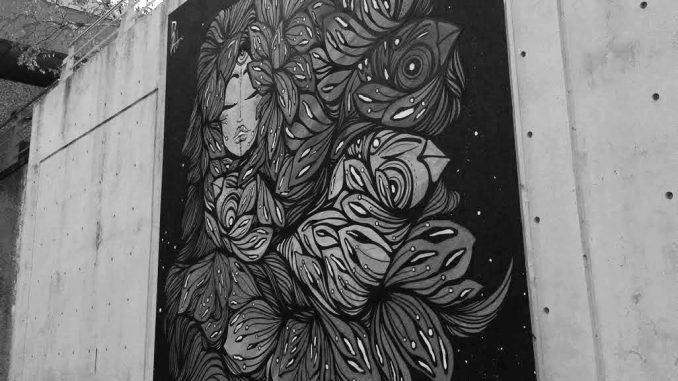
World-renowned street artist and activist Pau Quintanajornet, more commonly known as PAU, added her artistic touch to the walls of SUNY New Paltz last week.
The street artist visited New Paltz to paint and speak at a panel with professors Dr. Jessica Pabón and Dr. César Barros for the college’s annual “Without Limits” series, which celebrates interdisciplinary liberal arts education.
The theme for this year’s rendition of “Without Limits?” Screens and Scenes, said Pabón, who orchestrated PAU’s participation in the event. This was ideal for Pabón, whose academic research focuses on communities of street artists and “graffiti grrlz” around the world. Many women graffiti artists use the Web to organize and communicate, Pabón said.
According to Pabón, PAU’s on-campus creation, located outside on a wall between the Fine Arts Building and Sojourner Truth Library, is 12 feet tall by 12 feet wide. The mural took four days to finish, with the second day of painting postponed due to poor weather conditions.
PAU’s visit to campus has been in the works since November 2015, Pabón said. The professor submitted her proposal for PAU to paint on campus to the college’s Art and Aesthetics Committee, who then submitted the document to the school’s administrative cabinet. Administration approved Pabón’s plan with one stipulation: PAU couldn’t paint directly on the campus’s cement walls.
To work around this, Pabón and the administration agreed to drill a canvas into the wall as a surface for the artist to use. There are plans in the works to create a rotating gallery on the same wall with more art panels from other visiting artists, Pabón said.
The professor was happy that PAU’s work was the first to christen the gallery wall: according to Pabón, she and PAU have worked together online since 2009. It was only when the street artist came to campus to paint and participate in the panel that the two finally met in person.
Born in Chile and based in Berlin, Germany, PAU has decorated the walls of cities all across Europe, Africa and the Americas. The artist described her colorful signature style as symbolic: women are her subjects of choice since women personify creation and “the origin of the universe,” PAU said. Other motifs like birds, tattoos and stars often appear in her murals, which she attributed to her love of nature, travel and the cosmos.
For PAU, creating murals is more than an artistic endeavor: it’s a means for communication and social change. The artist believes that street art can change perspectives, which was the key idea behind the creation of Project Wallflowers. Project Wallflowers uses art as a means of “empowerment and self-reflection,” according to PAU’s website. The artist made it her goal to establish a network of beautiful, colorful street art projects around the globe, which passersby can interact with during and after their completion.
The project has become bigger than herself, PAU said, with other street artists around the world adopting her mission to foster community and build relationships.
“We have a huge network where we can actually create and change something as street artists and muralistas,” PAU said.
